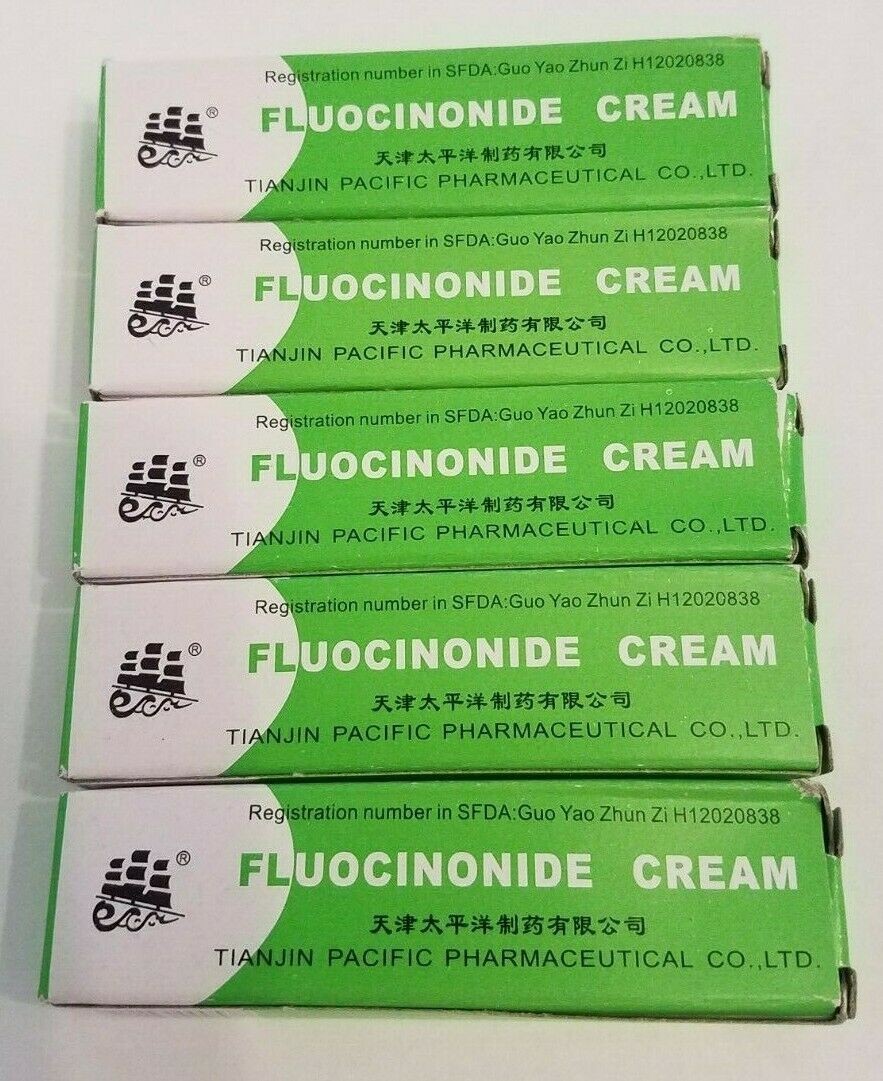
Contents
- 1 Fluocinonide
- 1.0.1 Warnings
- 1.0.2 What are the side effects of fluocinonide?
- 1.0.3 What are the dosages of fluocinonide?
- 1.0.4 What drugs interact with fluocinonide?
- 1.0.5 Pregnancy and breastfeeding
- 1.0.6 What else should I know about fluocinonide?
- 1.0.7 Subscribe to MedicineNet’s Skin Care & Conditions Newsletter
- 1.0.8 Summary
Fluocinonide
Fluocinonide is a corticosteroid medication used topically to treat inflammatory skin conditions like atopic dermatitis, psoriasis, and other conditions that respond to corticosteroid treatment. It relieves dryness, redness, itching, scaling, crusting, and other discomforts associated with these conditions.
Fluocinonide is a potent anti-inflammatory agent that suppresses inflammation by inducing the synthesis of lipocortins, proteins that inhibit the phospholipase 2 enzyme responsible for initiating inflammatory activity. It binds to glucocorticoid receptors on cell membranes, activating multiple processes that reduce inflammation:
- Inhibiting the release of proinflammatory substances like prostaglandin, histamine, and kinins
- Stabilizing the membranes of leukocytes and lysosomes, preventing the release of destructive chemicals
- Preventing the migration and aggregation of inflammatory cells to the affected area
- Reducing capillary permeability to prevent the leakage of inflammatory cells and proteins (cytokines) into the site of inflammation
- Preventing the migration of fibroblasts, cells that form the extracellular matrix, and inhibiting scar tissue formation
Warnings
- Avoid using fluocinonide if you are hypersensitive to it or any of its components.
- Topical use of fluocinonide can cause reversible suppression of the hypothalamic-pituitary-adrenal (HPA) axis with the potential for adrenal insufficiency, particularly in young children.
- Systemic absorption can also lead to Cushing’s syndrome, hyperglycemia, and glycosuria.
- Risk factors for increased systemic absorption include using high-potency steroids, applying over large skin areas, prolonged use, use with occlusive bandages, and applying to compromised skin.
- Monitor patients for symptoms of HPA axis suppression and adjust the treatment accordingly if symptoms develop.
- HPA axis function generally returns to normal after discontinuation of corticosteroid therapy. Symptoms of adrenal insufficiency may require supplemental systemic corticosteroids.
- Prolonged topical corticosteroid therapy may interfere with growth and development in children. Regularly monitor growth in young children.
- Limit the use of high-potency corticosteroids to less than 2 weeks. If treatment continues for a longer period, switch to a lower potency steroid.
- Avoid using medium or high-potency corticosteroids on the face, skin folds, and groin, as it can increase systemic absorption.
- Prolonged use, occlusion, or use of high-potency corticosteroids can cause local adverse reactions, including skin atrophy. Even short-term use can cause skin reactions when used on the face or in skin folds.
- Prolonged corticosteroid treatment is associated with Kaposi sarcoma, a type of cancer.
- If simultaneous skin infections occur, use appropriate antifungal or antibacterial agents. Discontinue fluocinonide until the infection is adequately controlled.
What are the side effects of fluocinonide?
Common side effects of fluocinonide include:
- Application site reactions, such as irritation, itching, pain, burning, swelling, redness, and discoloration
- Aggravation of the treated condition
Call your doctor immediately if you experience any of the following symptoms or serious side effects while using this drug:
- Serious heart symptoms, including fast or pounding heartbeats, fluttering in your chest, shortness of breath, and sudden dizziness
- Severe headache, confusion, slurred speech, severe weakness, vomiting, loss of coordination, feeling unsteady
- Severe nervous system reaction with very stiff muscles, high fever, sweating, confusion, fast or uneven heartbeats, tremors, and feeling like you might pass out
- Serious eye symptoms, such as blurred vision, tunnel vision, eye pain or swelling, or seeing halos around lights
This is not an exhaustive list of side effects or adverse reactions that may occur with the use of this drug. Contact your doctor for medical advice about serious side effects or adverse reactions. You can also report side effects or health problems to the FDA at 1-800-FDA-1088.
What are the dosages of fluocinonide?
Cream, External
- Vanos: 0.1%
- Generic: 0.05%, 0.1%
Ointment/Gel/Topical Solution
Adult:
Corticosteroid Responsive Dermatoses
- Apply a thin layer topically once daily or every 12 hours to affected areas
Pediatric:
Corticosteroid Responsive Dermatoses
Cream, gel, ointment, topical solution (0.05%):
Children and adolescents:
- Apply a thin layer to the affected area 2 to 4 times daily, depending on the severity of the condition; occlusive dressings may be used to manage psoriasis or recalcitrant conditions
Children aged 12 years and above and adolescents:
- Apply a thin layer once or twice daily to affected areas.
- Do not use it for longer than 2 consecutive weeks or exceed a total exposure of 60 g/week.
- Discontinue therapy when control is achieved. If no improvement is seen within 2 weeks, reassess the diagnosis.
Cream, gel, ointment, topical solution (0.05%):
Children and adolescents:
- Apply a thin layer to the affected area 2 to 4 times daily, depending on the severity of the condition.
- Note: In children under 12 years, NICE guidelines recommend applying it only once or twice daily (NICE 2007).
Children aged 12 years and above and adolescents:
- Apply a thin layer once daily to affected areas.
- Do not use it for longer than 2 consecutive weeks or exceed a total exposure of 60 g/week.
- Discontinue therapy when control is achieved. If no improvement is seen within 2 weeks, reassess the diagnosis.
Overdose
- Topical overdose of fluocinonide can cause skin eruptions, skin inflammation, burning, itching, and other skin reactions.
- Excessive absorption can lead to systemic effects, suppress the hypothalamus-pituitary-adrenal axis, and cause adrenal insufficiency. Symptoms usually resolve with drug withdrawal.
- Treat overdose by tapering off and discontinuing fluocinonide, and provide symptomatic care.
What drugs interact with fluocinonide?
Inform your doctor about all medications you are currently taking to check for possible drug interactions. Never start, stop, or change the dosage of any medication without your doctor’s recommendation.
- Severe interactions with fluocinonide include aldesleukin.
The above interactions are not exhaustive. For more information on drug interactions, visit the RxList Drug Interaction Checker.
Always inform your doctor, pharmacist, or healthcare provider about all prescription and over-the-counter medications you use, including the dosage, and keep a list of this information. If you have any questions about the medication, consult your doctor or healthcare provider.
Pregnancy and breastfeeding
- There are no adequate and well-controlled studies on the safety of using topical fluocinonide during pregnancy. Animal studies indicate that topical application of some corticosteroids can cause fetal harm. Use fluocinonide during pregnancy only if the potential benefits outweigh the potential risks to the fetus.
- Systemic corticosteroids are present in breast milk and can suppress growth, interfere with natural corticosteroid production, and cause other adverse effects in breastfed infants. It is not known if topical administration can result in sufficient systemic absorption for the drug to appear in milk. The decision to discontinue the drug or stop nursing should be made based on the importance of the drug to the mother.
What else should I know about fluocinonide?
- Use fluocinonide exactly as prescribed and do not apply it to larger skin areas or more frequently than recommended.
- Store it safely out of reach of children.
- In case of overdose, contact your physician or Poison Control.
Subscribe to MedicineNet’s Skin Care & Conditions Newsletter
By clicking "Submit," I agree to the MedicineNet Terms and Conditions and Privacy Policy. I also understand that I may opt out of MedicineNet subscriptions at any time.
Summary
Fluocinonide is a corticosteroid medication used topically to treat inflammatory skin conditions such as atopic dermatitis, psoriasis, and other conditions that respond to corticosteroid treatment. It relieves dryness, redness, itching, scaling, crusting, and other discomforts associated with these conditions. Common side effects include irritation, itching, pain, burning, swelling, redness, discoloration, aggravation of the treated condition, acne vulgaris, allergic dermatitis, contact dermatitis, perioral dermatitis, skin atrophy, striae, folliculitis, hypertrichosis, and others.


